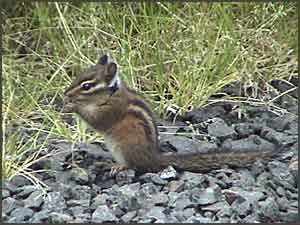Chipmunks
Townsend’s Chipmunk Video Clips

The only chipmunk species in Coastal Oregon, the Townsend's Chipmunk, is a member of the squirrel family, Sciuridae. It is the one of the largest chipmunks in North America with the head and body measuring between 5.5 and 6.5 inches. The tail is between 4 and 6 inches.
Both the Townsend's Chipmunk and the Douglas Squirrel were first noted by Lewis and Clark on February 25, 1806, at Fort Clatsop, Oregon.
The Townsend's Chipmunk, along with Townsend's Mole and Townsend's Warbler, are some of the mammals that were named after John Kirk Townsend. He was a naturalist and ornithologist who was invited to join an expedition across the Rocky Mountains to the Pacific Coast in 1883.
Townsend's Chipmunk Habitat
Surprisingly, chipmunks are not social - at least with their living quarters. Each chipmunk has its own underground burrow. The burrows are usually dug underneath bushes, rocks or logs. The entrance holes are 2 inches across and can be 5 feet long.
Chipmunks use straw, grass and other soft materials for their nests. Watch a video clip of a female Townsend's Chipmunk gathering straw for her nest.
Baby Chippies
Female chipmunks raise their young without any help from males. Because our climate is mild, chipmunks often have two litters. The young are born naked and blind.
Townsend's chipmunks mate in spring and in June, little chipmunks are out and about learning about life and having fun. Watch a video clip of two young Townsend's chipmunks in a tussle boxing with each other.
Food Choices
Our chipmunks are especially fond on black-oil sunflower seeds. However, when the chips are down, they will eat sunflower chips. We often see them eating blackberries, blueberries, strawberries and other native berries along with various grass and plant seeds.
BritishColumbia wonderfully describes the process a chipmunk uses when it finds food. They write, "When preparing food for storage, the chipmunk holds fruit and seeds in its dexterous front paws, and with specialized incisors, which are especially long and directed forward, it removes seeds from pods. Then it uses its tongue to shift them backwards and stuff them between its teeth and the extensible skin in the cheek area, where they are held while the animal collects more food. The capacity of these cheek pouches increases with maturity. When the cheek pouches become full, the chipmunk deposits the seeds in its nest or buries them in shallow holes that it digs in the ground and then covers with earth, leaves, and other litter."
If you've ever wondered how far a chipmunk can travel for food, the Ministry of Environment in British Columbia, says "Townsend's Chipmunks have been observed traveling up to one kilometer to reach a good foraging spot where they proceed to stuff their cheek-pouches and promptly return to their den for consumption or caching of their booty (Woods 1980)."
Chipmunk Indian Legend
There is a wonderful Iroquois Indian legend about Chipmunk and Bear that is a must read.
Chipmunk Stories
There are some great stories about chipmunks on the internet. One is a personal story about chipmunks called Toni's Territory. It's a very entertaining site. Another eloquent article is Marty Stouffer at Yosemite National Park.
